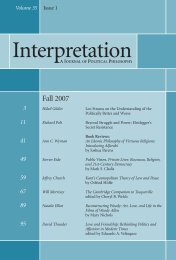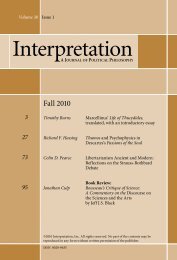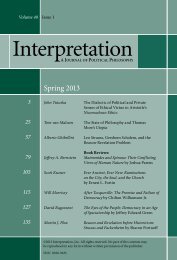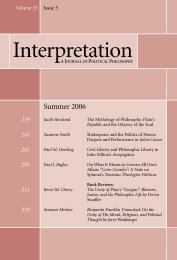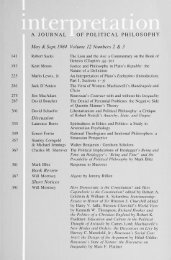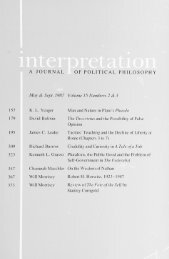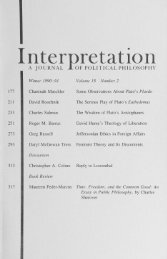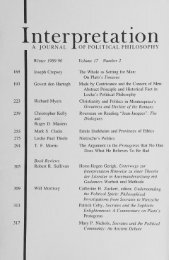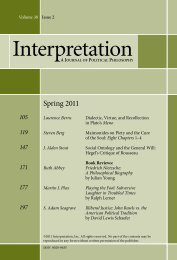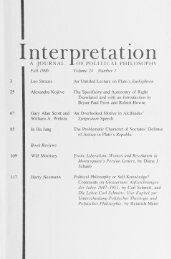Spring 2010 - Interpretation
Spring 2010 - Interpretation
Spring 2010 - Interpretation
You also want an ePaper? Increase the reach of your titles
YUMPU automatically turns print PDFs into web optimized ePapers that Google loves.
2 8 8<br />
I n t e r p r e t a t i o n<br />
It is only “in God” that we come to recognize Mind in the<br />
civil world of our making; for that world could not have been made without<br />
Mind; but this Mind could not be that of Romulus, the mythical brute<br />
founder of ancient Rome. The Mind in question must be divine or divined.<br />
Ultimately, the Mind of Nations must be God—purissima mens. The true<br />
Author of the World of Nations is not deluded man, but God Himself guiding<br />
the makings of men beyond their selfish interests, to serve one “common<br />
good” (ben comune) identical with the providential conservation of Cities<br />
(SN44, “Idea of the Work,” par. 4, 10-12, 24; Bk. I.21; Bk. II.2.iv, par. 14; Bk.<br />
II.5.v, par. 1; SN30, par. 26).<br />
The Question of the Convertibility of the True<br />
and the Made<br />
All of Vico’s arguments notwithstanding, Frye might object<br />
that what the philosopher appears to hold as “true” is to be understood as<br />
the product of his own “making”—assuming that what is true is identical<br />
to what is made. Accordingly, Frye might argue that Vico’s Scienza Nuova<br />
is to be read as a “poetic” or mythical narration wherein mythology (or the<br />
interpretation of myth) is indistinguishable from what is altogether mythical.<br />
After all, Vico himself indicates that “logοs…first and properly signified<br />
‘fable’” (SN44, Bk. II.2.i, par. 2). Indeed, the literary critic states: “We have<br />
invoked Vico’s axiom verum factum, that what is true is what we have made<br />
true, as an essential axiom of criticism” (Frye 1992, 135). But did Vico ever<br />
profess the unqualified identity of the true and the made?<br />
Even beyond Paolo Cristofolini’s accurate reminder that “the<br />
verum ipsum factum of the De Antiquissima (1710) does not reappear in the<br />
axiomatic implant nor in other places in the three redactions of the Scienza<br />
Nuova” (2001, 15), it remains to be seen if even in the De Antiquissima Vico<br />
ever claimed that what is true is plainly identical to what is made, i.e., that we<br />
cannot understand what we do not make, or that human understanding is<br />
essentially “poetic” in the Greek sense of “fabricating.”<br />
As if in silent anticipation of the Scienza Nuova, but explicitly<br />
pointing back to both “Platonic” and “Aristotelian metaphysics,” in 1710<br />
Vico presents his De Antiquissima Italorum Sapientia as sketching “the<br />
design of one entire metaphysics, in which, as for the good proportion of the<br />
drawing, it is required that—given one’s writing as citizen of a republic that<br />
is Christian—the matters be treated ‘dressed appropriately’ [acconciamente]<br />
for the Christian religion” (Risposta 1711, part. 2, par. 1; cf. SN44, Bk. IV.14.



